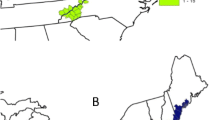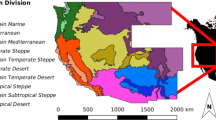Abstract
The interagency Forest Health Monitoring Program involves a network of about 4200 forest plots on a triangular grid across the United States. We present data on recent mortality of trees ≥27.9 cm diameter from the first three years of measurements in California (1992–1994). Three plot designs were used to collect data representative of a 1-ha stand at each site; the designs differed primarily in total area sampled (0.067, 0.4 and 1.0 ha). Approximately 50 sites were visited each year yielding a total of about 150. Field tallies showed few cases of recent mortality in the smallest plot size. Cumulative distribution functions of recent dead tree densities in the 0.067-ha plots differed significantly from those generated by tallies from entire 1-ha stands. We conclude that an area of 0.067 ha is unsuitable to assess and monitor overstory mortality in Pacific Coast forests.
Similar content being viewed by others
References
Auclair, A. N. D.: 1987, The climate change theory of forest decline. IUFRO Conference on Woody Plant Growth in a Changing Physical and Chemical Environment, Vancouver, Canada.
Busing, R. T., Liegel, L. H. and LaBau, V. J.: 1995, Evaluating overstory trees to assess health of Pacific Coast forests (in review).
Busing, R. T. and Pauley, E. F.: 1994, ‘Mortality trends in a southern Appalachian red spruce population’, Forest Ecology and Management 64, 41–45.
Eagar, C. and Adams, M. B.: 1992, Ecology and decline of red spruce in the eastern United States. Springer-Verlag, New York.
Forest Health Monitoring: 1994, Forest health monitoring 1992 annual statistical summary. U.S. Environmental Protection Agency, Washington, D.C.
Franklin, J. F.: 1988, ‘Pacific Northwest forests’, in: North American Terrestrial Vegetation. M. G. Barbour and W. D. Billings. (eds.) Cambridge University Press, New York. pp. 103–130.
Gates, D. M.: 1993, Climate change and its biological consequences. Sinauer, Sunderland, Massachusetts.
Harcombe, P. A.: 1987, ‘Tree life tables’, BioScience 37, 557–568.
Harrington, J. B.: 1987, ‘Climatic change: a review of causes’, Canadian Jour. Forest Research 17, 1313–1339.
Klein, R. M. and Perkins, T. D.: 1988, ‘Primary and secondary causes and consequences of contemporary forest decline’, Botanical Review 54, 1–43.
LaBau, V. J.: 1993, ‘Regional monitoring with plot networks’, Envir. Monitoring and Assessment 26, 283–294.
Loucks, O. L.: 1992, ‘Forest response research in NAPAP: potentially successful linkage of policy and science’, Ecological Applications 2, 117–123.
McLaughlin, S. B.: 1985, ‘Effects of air pollution on forests: a critical review’, Jour. Air Pollution Control Assoc. 35, 512–534.
Palmer, C. J., Riitters, K. H., Strickland, T., Cassell, D. L., Byers, G. E., Papp, M. L. and Liff, C. I.: 1991, Monitoring and research strategy for forests. EPA/600/4-91/012. U.S. Environmental Protection Agency, Washington, D.C.
Peart, D. R., Nicholas, N. S., Zedaker, S. M., Miller-Weeks, M. M. and Siccama, T. G.: 1992, ‘Condition and recent trends in high-elevation red spruce populations’, in: Ecology and decline of red spruce in the eastern United States C. Eagar and M. B. Adams (eds.), Springer-Verlag, New York. pp. 125–191.
Riitters, K. H., Law, B. E., Kucera, R. C., Gallant, A. L., DeVelice, R. L. and Palmer, C. J.: 1992, ‘A selection of forest condition indicators for monitoring’, Envir. Monitoring and Assessment 26, 21–33.
Shaw, C. G.: 1993, ‘Forest health monitoring—a new program of the USDA Forest Service and Environmental Protection Agency’, IUFRO Remote Sensing and World Forest Monitoring International Workshop, Pattaya, Thailand, January 13–17, 1992.
Sokal, R. R. and Rohlf, F. J.: 1969, Biometry. Freeman and Co., San Francisco.
Tallent-Halsell, N. G. (ed.): 1994, Forest health monitoring 1994 field methods guide. EPA/620/R-94/027. U.S. Environmental Protection Agency, Las Vegas, Nevada.
Tritton, L. M. and Siccama, T. G.: 1990, ‘What proportion of standing trees in forests of the Northeast are dead?’, Bulletin of the Torrey Botanical Club 117, 163–166.
Waring, R. H.: 1987, “Characteristics of trees predisposed to die’, BioScience 37, 569–574.
Waring, R. H. and Franklin, J. F.: 1979, ‘Evergreen coniferous forests of the Pacific Northwest’, Science 204, 1380–1386.
Author information
Authors and Affiliations
Additional information
The U.S. government right to retain a non-exclusive, royalty free licence in and to any copyright is acknowledged.
Rights and permissions
About this article
Cite this article
Busing, R.T., Liegel, L.H. & Labau, V.J. Overstory mortality as an indicator of forest health in California. Environ Monit Assess 42, 285–295 (1996). https://doi.org/10.1007/BF00414374
Received:
Revised:
Issue Date:
DOI: https://doi.org/10.1007/BF00414374




